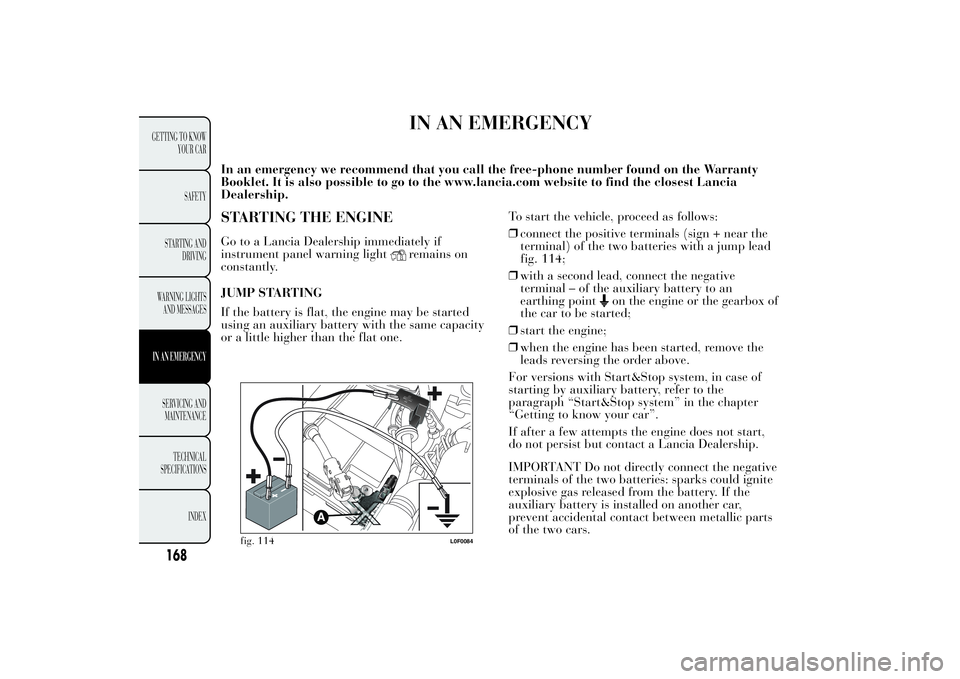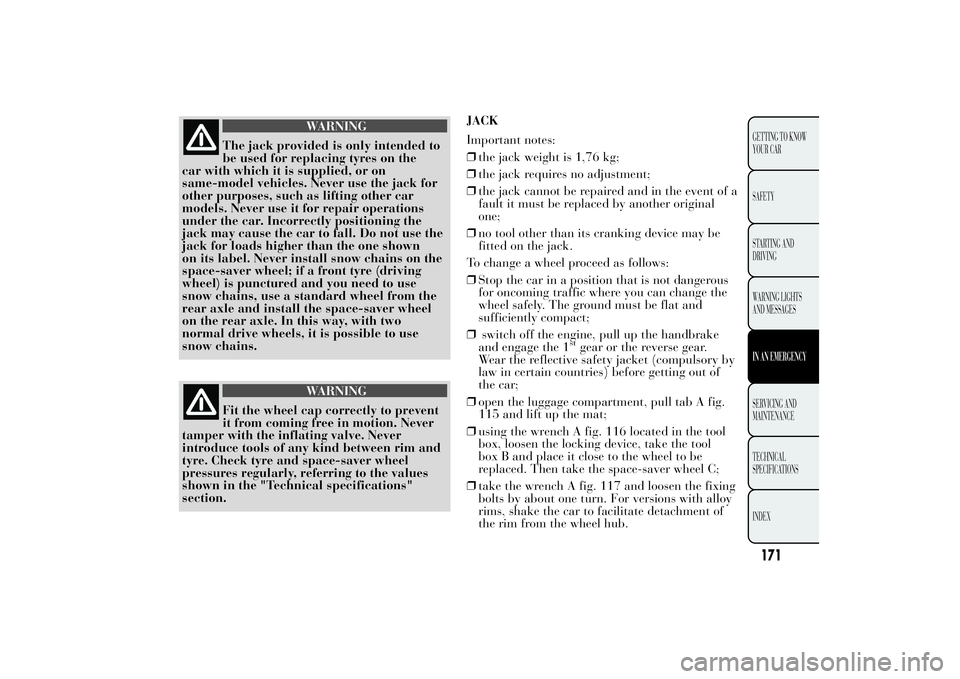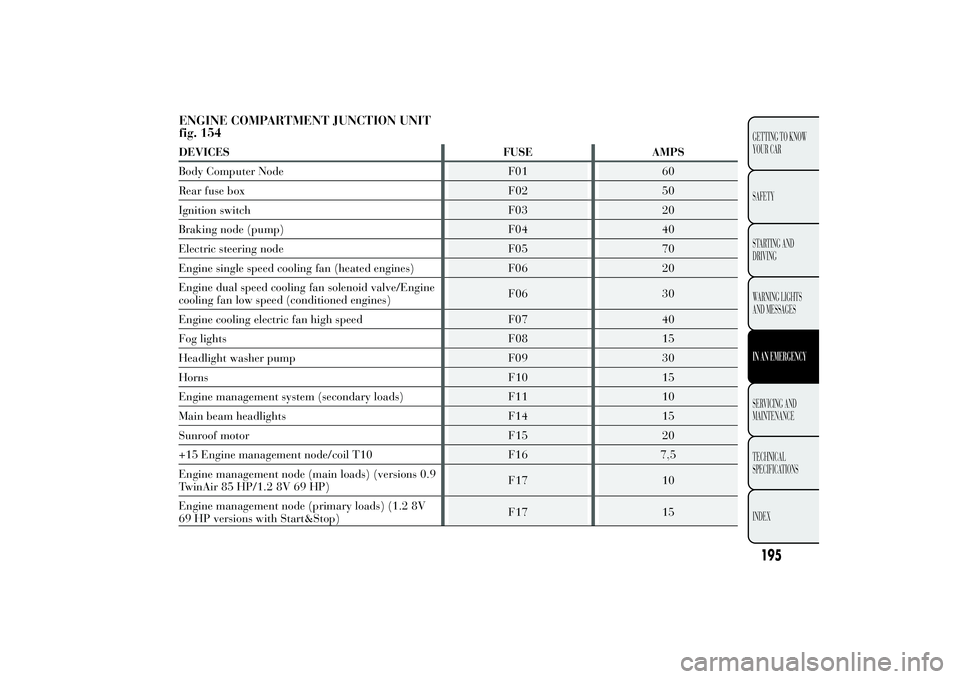stop start Lancia Ypsilon 2012 Owner handbook (in English)
[x] Cancel search | Manufacturer: LANCIA, Model Year: 2012, Model line: Ypsilon, Model: Lancia Ypsilon 2012Pages: 307, PDF Size: 13.3 MB
Page 164 of 307

“DUALDRIVE” ELECTRIC POWER
STEERING FAILURE (red)
This warning light switches on when the ignition
key is turned to MAR, but it should switch off
after a few seconds.
If the warning light (or, on some versions, a
message and a symbol on the display) remains on,
you may not have steering assistance and the
effort required to operate the steering wheel could
be notably increased; steering is, however,
possible. In this case, contact a Lancia Dealership.
IMPORTANT In some circumstances, factors
independent of the electric power steering could
cause the warning light on the instrument panel to
switch on. In this case, stop the car immediately,
switch off the engine for about 20 seconds and
then restart the engine. If the warning light (or, on
some versions, a message and a symbol on the
display) remains on constantly, contact a Lancia
Dealership.
IMPORTANT After the battery is disconnected,
the steering must be initialised. The warning light
switches on to indicate this. To carry out this
procedure, simply turn the steering wheel all the
way from one end to the other or drive in a
straight line for about a hundred metres.
CRUISE CONTROL (green)
(for versions/markets, where provided)
This warning light switches on when the ignition
key is turned to MAR, but it should switch off
after a few seconds, if the Cruise Control is
deactivated.
The warning light switches on when the Cruise
Control ring nut is turned to the ON position (see
the “Cruise Control” paragraph in the "Knowing
your car" section). On some versions the display
shows the dedicated message.DPF (PARTICULATE FILTER) BEING
CLEANED
(only Diesel versions with DPF) (amber)
Turning the key to the MAR-ON position
illuminates the warning light, but it should switch
off after a few seconds.
The warning light (together with a message and a
symbol on the display on some versions) switches
on constantly to notify the driver that the DPF
system needs to eliminate captured pollutants
(particulate) through the regeneration process.
162
GETTING TO KNOW
YOUR CAR
SAFETY
STARTING AND
DRIVINGWARNING LIGHTS
AND MESSAGESIN AN EMERGENCY
SERVICING AND
MAINTENANCE
TECHNICAL
SPECIFICATIONS
INDEX
Page 165 of 307

The warning light does not come on during every
DPF regeneration, but only when driving
conditions require that the driver is notified. To
switch the warning light off, the car must be kept
moving until the regeneration process is
completed.
As an average, the process lasts fifteen minutes.
The best conditions to complete the regeneration
process are reached driving the car at about 60
km/h with engine speed over 2000 rpm.
When this warning light switches on, it does not
indicate a fault with the car and it should
therefore not be taken to a workshop. A specific
message will appear on the display when the
warning light comes on (for versions/markets,
where provided).
WARNING
The driving speed should always be
suitable to traffic conditions, weather
conditions and the driver should always
comply with the Highway Code. The engine
may be turned off while the DPF light is
on; however, repeated interruption of the
regeneration process may result in
premature exhaustion of engine oil. For this
reason, always wait until the warning light
switches off before stopping the engine as
described above. It is not a good idea to
complete DPF regeneration with the
car stationary.
GENERIC FAILURE INDICATION
(amber)
(for versions/markets, where provided)
The warning light switches on in the following
circumstances. In these cases contact a Lancia
Dealership to have the fault fixed as soon as
possible.
Speed limit exceeded
(for versions/markets, where provided)
The warning light switches on (together with a
message on the display) when the speed limit set
in the Setup Menu is exceeded.
When the car exceeds this value, on some versions
a message and a symbol are shown in the display
and an acoustic signal is emitted.
Fuel cut-off system intervention/fault
(for versions/markets, where provided)
The warning light switches on (together with a
message on the display) in the event of fuel cut-off
system intervention/fault.
Start&Stop failure
(for versions/markets, where provided)
The warning light switches on (together with a
message on the display) when a Start&Stop
system failure is detected.
163GETTING TO KNOW
YOUR CAR
SAFETY
STARTING AND
DRIVINGWARNING LIGHTS
AND MESSAGESIN AN EMERGENCY
SERVICING AND
MAINTENANCE
TECHNICAL
SPECIFICATIONS
INDEX
Page 168 of 307

DOORS/BONNET/LUGGAGE
COMPARTMENT OPEN
The warning light switches on (on some versions
together with a message and a symbol in the
display) when one or more doors, the boot or the
bonnet or the tailgate are not properly closed.
An acoustic signal is activated with the doors open
and the car moving.
START&STOP SYSTEM ACTIVATION/
DEACTIVATION
START&STOP SYSTEM FAILURE
Start&Stop system activation
A message will be displayed when the Start&Stop
system is on. In this condition the LED on the
button on the dashboard control panel (see
“Start&Stop” in the chapter "Knowing your car")
is off.
Turning the Start&Stop off
❒Versions with reconfigurable multifunction
display:a message appears on the display when
the Start&Stop system is deactivated.
❒Versions with reconfigurable multifunction
display:the
symbol and a message appear on
the display when the Start&Stop system is
deactivated.
The LED on the
button is on when the system
is deactivated.START&STOP SYSTEM FAILURE
Versions with multifunction display: the
warning light on the instrument panel switches
on and a message appears on the display in the
event of Start&Stop system failure.
Versions with reconfigurable multifunction
display:the
icon switches on and a message
appears on the display in the event of a
Start&Stop system failure.
In the event of a Start&Stop system failure,
contact a Lancia Dealership.
POSSIBLE ICE ON ROAD
(for versions/markets where provided)
On the versions equipped with reconfigurable
multifunction display, a message + symbol appear
on the display when the outdoor temperature
falls to or below 3°C.
IMPORTANT In the event of outdoor temperature
sensor failure, dashes are shown on the display
instead of the value.
166
GETTING TO KNOW
YOUR CAR
SAFETY
STARTING AND
DRIVINGWARNING LIGHTS
AND MESSAGESIN AN EMERGENCY
SERVICING AND
MAINTENANCE
TECHNICAL
SPECIFICATIONS
INDEX
Page 170 of 307

IN AN EMERGENCY
In an emergency we recommend that you call the free-phone number found on the Warranty
Booklet. It is also possible to go to the www.lancia.com website to find the closest Lancia
Dealership.STARTING THE ENGINEGo to a Lancia Dealership immediately if
instrument panel warning light
remains on
constantly.
JUMP STARTING
If the battery is flat, the engine may be started
using an auxiliary battery with the same capacity
or a little higher than the flat one.To start the vehicle, proceed as follows:
❒connect the positive terminals (sign + near the
terminal) of the two batteries with a jump lead
fig. 114;
❒with a second lead, connect the negative
terminal – of the auxiliary battery to an
earthing point
on the engine or the gearbox of
the car to be started;
❒start the engine;
❒when the engine has been started, remove the
leads reversing the order above.
For versions with Start&Stop system, in case of
starting by auxiliary battery, refer to the
paragraph “Start&Stop system” in the chapter
“Getting to know your car”.
If after a few attempts the engine does not start,
do not persist but contact a Lancia Dealership.
IMPORTANT Do not directly connect the negative
terminals of the two batteries: sparks could ignite
explosive gas released from the battery. If the
auxiliary battery is installed on another car,
prevent accidental contact between metallic parts
of the two cars.
fig. 114
L0F0084
168
GETTING TO KNOW
YOUR CAR
SAFETY
STARTING AND
DRIVING
WARNING LIGHTS
AND MESSAGESIN AN EMERGENCYSERVICING AND
MAINTENANCE
TECHNICAL
SPECIFICATIONS
INDEX
Page 172 of 307

WARNING
If you change the type of wheel (alloy
rims instead of steel rims and vice
versa) you will have to change the entire set
of fastening bolts with another set of suitably
sized bolts.
WARNING
Alert other drivers that the car is
stationary in compliance with local
regulations: hazard warning lights, warning
triangle, etc. Any passengers on board
should leave the car, especially if it is
heavily laden. Passengers should stay away
from on-coming traffic while the wheel is
being changed. On hills or uneven roads, use
chocks or appropriate objects to block the
wheels of the car.
WARNING
The car's driving characteristics will
be modified with the space-saver
wheel fitted. Avoid sudden starting or
stopping, sharp or fast turns. The total life of
a space-saver wheel is approximately 3000
km, after which it must be replaced by
another wheel of the same type. Never install
a standard tyre on a rim that is designed
for use with a space-saver wheel. Have the
tyre repaired and refitted as soon as
possible. Using two or more space-saver
wheels at the same time is forbidden. Do not
grease the threads of bolts before fitting
them: they might slip out.
170
GETTING TO KNOW
YOUR CAR
SAFETY
STARTING AND
DRIVING
WARNING LIGHTS
AND MESSAGESIN AN EMERGENCYSERVICING AND
MAINTENANCE
TECHNICAL
SPECIFICATIONS
INDEX
Page 173 of 307

WARNING
The jack provided is only intended to
be used for replacing tyres on the
car with which it is supplied, or on
same-model vehicles. Never use the jack for
other purposes, such as lifting other car
models. Never use it for repair operations
under the car. Incorrectly positioning the
jack may cause the car to fall. Do not use the
jack for loads higher than the one shown
on its label. Never install snow chains on the
space-saver wheel; if a front tyre (driving
wheel) is punctured and you need to use
snow chains, use a standard wheel from the
rear axle and install the space-saver wheel
on the rear axle. In this way, with two
normal drive wheels, it is possible to use
snow chains.
WARNING
Fit the wheel cap correctly to prevent
it from coming free in motion. Never
tamper with the inflating valve. Never
introduce tools of any kind between rim and
tyre. Check tyre and space-saver wheel
pressures regularly, referring to the values
shown in the "Technical specifications"
section.JACK
Important notes:
❒the jack weight is 1,76 kg;
❒the jack requires no adjustment;
❒the jack cannot be repaired and in the event of a
fault it must be replaced by another original
one;
❒no tool other than its cranking device may be
fitted on the jack.
To change a wheel proceed as follows:
❒Stop the car in a position that is not dangerous
for oncoming traffic where you can change the
wheel safely. The ground must be flat and
sufficiently compact;
❒switch off the engine, pull up the handbrake
and engage the 1
stgear or the reverse gear.
Wear the reflective safety jacket (compulsory by
law in certain countries) before getting out of
the car;
❒open the luggage compartment, pull tab A fig.
115 and lift up the mat;
❒using the wrench A fig. 116 located in the tool
box, loosen the locking device, take the tool
box B and place it close to the wheel to be
replaced. Then take the space-saver wheel C;
❒take the wrench A fig. 117 and loosen the fixing
bolts by about one turn. For versions with alloy
rims, shake the car to facilitate detachment of
the rim from the wheel hub.
171GETTING TO KNOW
YOUR CAR
SAFETY
STARTING AND
DRIVING
WARNING LIGHTS
AND MESSAGESIN AN EMERGENCYSERVICING AND
MAINTENANCE
TECHNICAL
SPECIFICATIONS
INDEX
Page 180 of 307

tyre pressure on gauge B fig. 125 with
compressor off to obtain a more precise reading;
❒if after five minutes it is still impossible to reach
at least 1.8 bar, disengage the compressor from
the valve and power socket, then move the
car forwards by approx. ten metres in order to
distribute the sealing fluid inside the tyre evenly,then repeat the inflation operation;
❒if after this operation you still cannot reach at
least 1.8 bar after 5 minutes from switching
on the compressor, do not resume driving but
contact a Lancia Dealership;
WARNING
Apply the adhesive label where it can
be easily seen by the driver as a
reminder that the tyre has been treated with
the tyre quick repair kit. Drive carefully,
particularly on bends. Do not exceed 80
km/h. Do not accelerate or brake suddenly.
❒after driving for about 10 minutes stop and
check the tyre pressure again;pull up the
handbrake;For the safety of the car when it is
parked, follow the indication in the paragraph
"When parked" in the chapter "Starting up and
driving" .
WARNING
If the pressure has fallen below 1.8
bar, do not drive any further: the
automatic tyre quick repair kit cannot
guarantee the correct hold because the tyre
is too damaged. Contact a Lancia
Dealership.
fig. 125
L0F0181
fig. 126
L0F0178
178
GETTING TO KNOW
YOUR CAR
SAFETY
STARTING AND
DRIVING
WARNING LIGHTS
AND MESSAGESIN AN EMERGENCYSERVICING AND
MAINTENANCE
TECHNICAL
SPECIFICATIONS
INDEX
Page 197 of 307

ENGINE COMPARTMENT JUNCTION UNIT fig. 154
195GETTING TO KNOW YOUR CAR SAFETYSTARTING AND DRIVING WARNING LIGHTS AND MESSAGESIN AN EMERGENCYSERVICING ANDMAINTENANCE TECHNICAL SPECIFICATIONS INDEX DEVICES FUSE AMPS Body Computer Node F01 60Rear fuse box F02 50Ignition switch F03 20Braking node (pump) F04 40Electric steering node F05 70Engine single speed cooling fan (heated engines) F06 20Engine dual speed cooling fan solenoid valve/Engine cooling fan low speed (conditioned engines)
F06 30
Engine cooling electric fan high speed F07 40 Fog lights F08 15Headlight washer pump F09 30Horns F10 15Engine management system (secondary loads) F11 10Main beam headlights F14 15Sunroof motor F15 20+15 Engine management node/coil T10 F16 7,5Engine management node (main loads) (versions 0.9 TwinAir 85 HP/1.2 8V 69 HP)
F17 10
Engine management node (primary loads) (1.2 8V 69 HP versions with Start&Stop)
F17 15
Page 201 of 307

BATTERY RECHARGINGIMPORTANT The battery recharging procedure is
given as information only. You are advised to go
to a Lancia Dealership to have this operation
performed.
Low amperage slow recharging for approximately
24 hours is advised. Charging for a longer time
may damage the battery.
VERSIONS WITHOUT Start&Stop SYSTEM
(for versions/markets, where provided)
Charge the battery as follows:
❒disconnect the negative battery terminal;
❒connect the charger cables to the battery
terminals, observing the polarity;
❒turn on the charger;
❒when finished, turn the charger off before
disconnecting the battery;
❒reconnect the negative battery terminal.
VERSIONS WITH Start&Stop SYSTEM
(for versions/markets, where provided)
Charge the battery as follows:
❒disconnect the connector A fig. 159 (pressing
the button B) from the sensor C monitoring
the battery conditions, on the negative pole D of
the battery;
fig. 159
L0F0229
199GETTING TO KNOW
YOUR CAR
SAFETY
STARTING AND
DRIVING
WARNING LIGHTS
AND MESSAGESIN AN EMERGENCYSERVICING AND
MAINTENANCE
TECHNICAL
SPECIFICATIONS
INDEX
Page 204 of 307

WARNING
Before towing, turn the ignition key to
MAR and then to STOP without
removing it. The steering column will
automatically lock when the key is removed
and the wheels cannot be steered.
WARNING
Before tightening the hook clean the
threaded housing thoroughly. Make
sure that the hook is fully fastened in the
housing before towing the car.
WARNING
Whilst towing, remember that as the
assistance of the brake servo and
the electric power assisted steering is not
available, greater force needs to be exerted
on the brake pedal and more effort is
required on the steering wheel. Do not use
flexible cables when towing and avoid jerky
movements. During towing, make sure that
the trailer hitch does not damage any
components it is touching. When towing the
car, it is compulsory to respect specific
highway code regulations relating to the tow
hook and procedures for towing on the
road. Do not start the engine while towing
the car.
fig. 161
L0F0022
202
GETTING TO KNOW
YOUR CAR
SAFETY
STARTING AND
DRIVING
WARNING LIGHTS
AND MESSAGESIN AN EMERGENCYSERVICING AND
MAINTENANCE
TECHNICAL
SPECIFICATIONS
INDEX